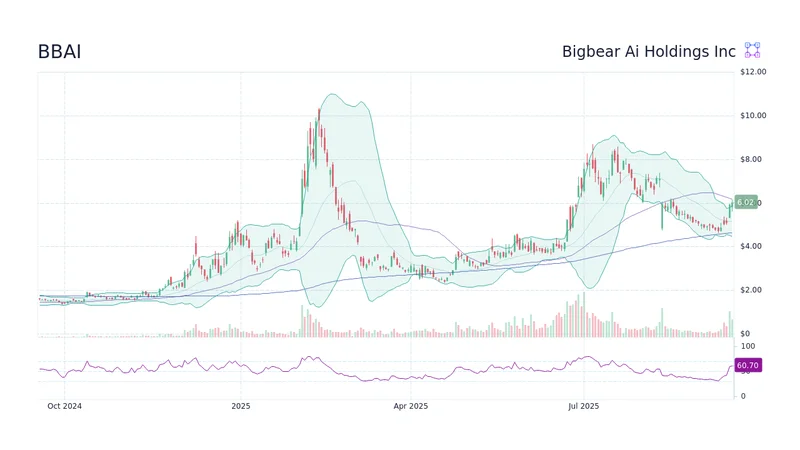BBAI Stock: The Investment Case vs. The Current Data
The Two Stories of BigBear.ai
There are two versions of BigBear.ai (BBAI) competing for investors' attention right now. The first is a compelling narrative, a story of cutting-edge artificial intelligence embedding itself deep within the U.S. national security apparatus. It’s a story of unmanned systems, facial recognition at airports, and a direct line into a proposed $13.4 billion pool of defense spending for autonomous systems. This is the story that caused the stock to more than double from its mid-April low.
The second version of BBAI is told not through press releases, but through financial statements and forward guidance. This story is less glamorous. It’s a story of continued losses, concerns over valuation, and a management team that recently felt compelled to reduce its revenue forecast for 2025. This is the version that has seen the stock price bleed out over the past few weeks, surrendering a chunk of its impressive gains.
As an analyst, my job is to reconcile these two competing narratives. The market, fueled by a general AI exuberance, has clearly favored the first story. But when a stock’s momentum is built on a narrative, it becomes incredibly fragile, susceptible to the slightest crack in the foundation. The question now is whether the underlying numbers can support the weight of the story that has been built on top of them.
A Disconnect Between Backlog and Outlook
The bull case for BigBear.ai is undeniably attractive. The company isn't just another AI startup chasing enterprise clients; it has established, high-stakes partnerships with the Joint Chiefs of Staff and the U.S. Navy. It’s involved in critical infrastructure like cargo screening at the Panama Canal. This isn't theoretical AI; it's applied intelligence in domains where failure is not an option. This proximity to government spending is the company’s primary asset, and it’s a powerful one.

The data seems to back this up, at least on the surface. The company’s reported backlog stands at a healthy $380 million, a figure that grew approximately 43% year-over-year in the second quarter. In a normal environment, a backlog growing at that pace would be a clear signal of accelerating future revenue. It’s the business you’ve already booked but haven’t yet delivered.
And this is the part of the analysis I find genuinely puzzling. A 43% YoY growth in backlog should, in theory, support confident, if not raised, guidance. Yet management’s decision to lower the FY2025 outlook creates a significant narrative discrepancy. Why would a company with a rapidly filling order book temper expectations for the near future? The stated reason points to uncertainty around the timing of new contract awards, exacerbated by the ongoing government shutdown. That’s a plausible explanation, but it also introduces a variable that’s entirely outside the company’s control.
This is the core of the problem identified by the 5-star investor known as Juxtaposed Ideas, who is ranked in the top 2% of analysts tracked by TipRanks. The assessment is clinical: the stock’s outsized rally, combined with the lowered guidance, has erased any "margin of safety." The stock, in essence, is a rocket that launched on the fuel of a powerful narrative. But now it’s hitting atmospheric turbulence, and we're about to find out if its actual financial engines—revenue and profitability—are strong enough to carry it into a stable orbit. The price was bid up on the promise of future contracts, but the timeline for those contracts has suddenly become opaque.
The recent rally saw the stock price climb by about 100%—to be more exact, the surge from the April trough was closer to 120% before the recent pullback. This kind of move prices in a lot of good news. When that news becomes less certain, a correction is not just possible; it's logical. It’s a recalibration of expectation versus reality. Wall Street’s consensus seems to reflect this tension, with a "Moderate Buy" rating that feels more like a nervous acknowledgment of potential than a full-throated endorsement. The average price target of $5.83 suggests an upside of just under 3% (a statistically insignificant margin), which tells you analysts see the stock as, at best, fairly valued at these levels.
A Narrative Waiting for Numbers
Ultimately, BigBear.ai is a story stock right now, and the story is very good. But an investment thesis cannot survive on narrative alone. The disconnect between a soaring backlog and cautious guidance is a yellow flag that can’t be ignored. The analysis from Juxtaposed Ideas isn't bearish; it's prudent. It's an acknowledgment that when the data becomes contradictory, the safest move is to ‘Wait Before Loading Up,’ Says Top Investor About BigBear AI (BBAI) Stock. For BBAI, that point is the Q3 earnings call on November 10. That call will be critical in providing clarity on the sales cycle and the real-world impact of federal disruptions. Until then, investors are holding a ticket for a flight that might be delayed. The destination is promising, but the departure time is unknown.
-

The Juan Gabriel 'Alive' Hoax: Deconstructing the Latest 'Proof'
So,JuanGabrielisaliveagain.I...
-

Jeff Bezos: His Net Worth, His Love Life, and Why We're All Obsessed
So,JeffBezoshasdescendedfrom...
-

Zcash's Sudden Price Surge: Analyzing the Catalysts and Its Future Outlook
Zcash'sViolentRally:Deconstruct...
-

Warren Buffett's OXY Stock Play: The Latest Drama, Buffett's Angle, and Why You Shouldn't Believe the Hype
Solet'sgetthisstraight.Occide...
-

Registered Investment Advisor (RIA): Defining the Role, Services, and Fee Structures
TheQuietRuleChangeThatWillRe...
- Search
- Recently Published
-
- Cidara Therapeutics: Stock, News, & The Usual Spin?
- ANyONe Protocol: What the hell is it, and is it even real?
- BMO: The Bank, The Stadium, The Cartoon, and Why You Should Care
- BBAI Stock: The Investment Case vs. The Current Data
- CoreWeave's Stock Nosedive: What They're Not Telling You
- IRS Relief Payment: Status, Timing, and What the Data Shows
- Zcash's "Historic Surge": Hayes is Hyping It?
- BMO: What is it and Where Can I Find One?
- Avelo Airlines: FAA Cuts and the Lakeland Linder Opportunity
- SpaceX Launch Today: What Happened and Launch Time Details
- Tag list
-
- carbon trading (2)
- Blockchain (11)
- Decentralization (5)
- Smart Contracts (4)
- Cryptocurrency (26)
- DeFi (5)
- Bitcoin (29)
- Trump (5)
- Ethereum (8)
- Pudgy Penguins (5)
- NFT (5)
- Solana (5)
- cryptocurrency (6)
- XRP (3)
- Airdrop (3)
- MicroStrategy (3)
- Stablecoin (3)
- Digital Assets (3)
- PENGU (3)
- Plasma (5)
- Zcash (6)
- Aster (4)
- investment advisor (4)
- crypto exchange binance (3)
- SX Network (3)
